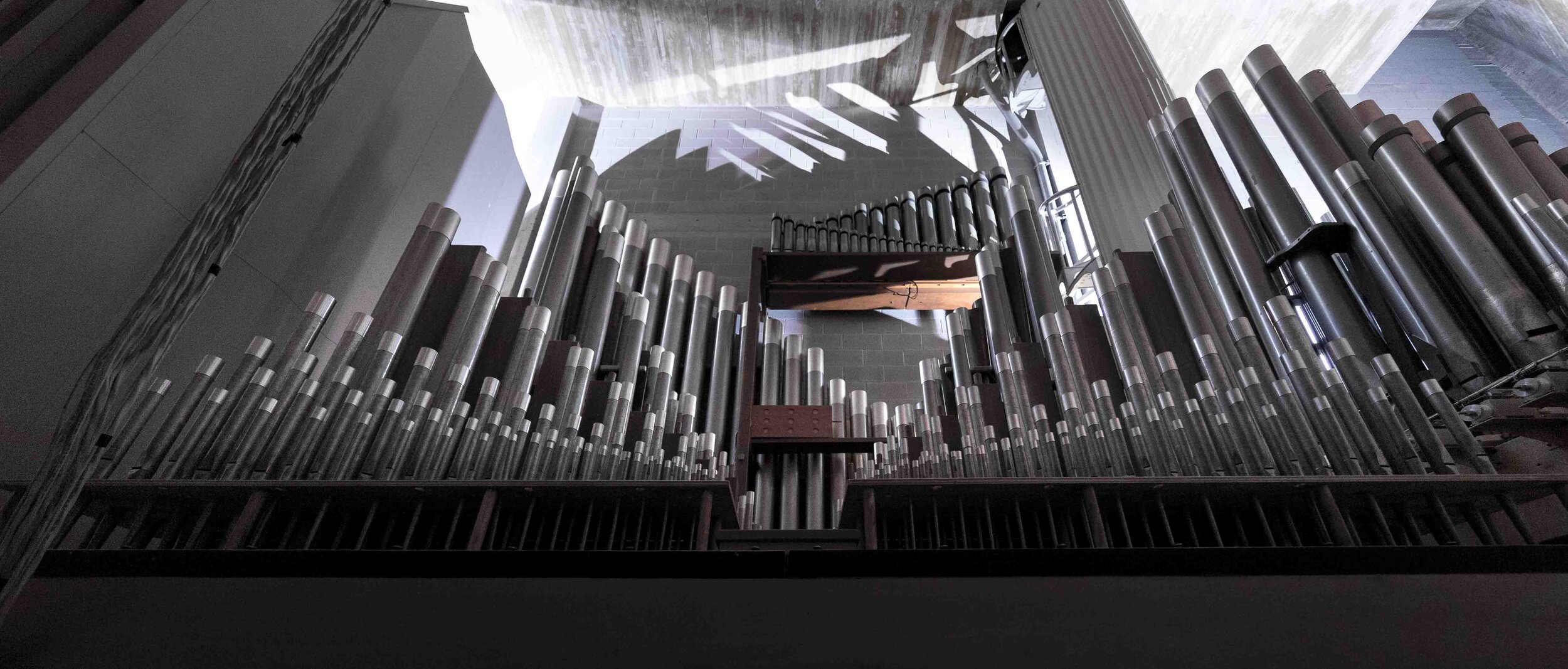The Holtkamp Organ
History, Description and Specification
Magnum Opus
The abbey church organ was the last large contract that Walter Holtkamp, Sr., completed before his death. He designed the instrument in consultation with Abbey organist, Father Gerard Farrell OSB, with additional input from inaugural recitalist, Flor Peeters (1903-1986) of Belgium, one of Fr. Gerard's teachers. It is acknowledged among organists to be one of the most important large masterpieces created by Holtkamp.
The Holtkamp Organ Company traces its lineage back to 1855—only one year older than the founding of Saint John's Abbey—when G.F. Votteler established an organ shop in Cleveland, Ohio. In 1903, the first Holtkamp, Herman Heinrich, came from St. Mary's, Ohio, to join the then retiring Henry Votteler. Control of the firm, now named Votteler Holtkamp Sparling Company, passed to Herman's son, Walter, in 1931. The Holtkamp Organ Company emerged in 1951.
Under the direction of Walter Holtkamp, Sr. (1894-1962), the reputation of the company grew until it became known as one of the finest in the country. Holtkamp was an early pioneer in this country of the so-called Orgelbewegung ("organ reform movement"). The movement was characterized by a departure from the orchestral tones of the previous generation. Musicians and organ builders alike sought a return to the centuries-old aesthetics of the pipe organ as an instrument for music of Bach, Buxtehude, Couperin and Frescobaldi, rather than transcriptions of Wagner and other 19th century orchestral composers.
Construction
Contracted in April, 1960, the instrument was completed in November, 1961. The organ pipes were placed behind a red cloth, acoustically transparent screen, chosen primarily for architectural considerations. With the interior of the church so monastically austere, not to mention large, a pipe display was thought to be inappropriate and, perhaps, might be dwarfed by the scale of the room. The organ was never conceived for concert use but, rather, to serve the monastic community at prayer.
Solemn Blessing and Dedication
The Holtkamp organ was blessed by Rt. Rev. Abbot Baldwin Dworschak, OSB on Saint Cecilia's Eve, 21 November 1961, at 8:30 p.m. Sir Flor Peeters, KSSil, KCSGreg, played the dedicatory recital that included works by Buxtehude, Dufay, Sweelinck, Bach, Handel, Franck, Messaien and the organist.
Organ Specifications
Pedal
16 Principal 32 Pipes
16 Subbass 39 Pipes
16 Quintadena Great
10 2/3 Quintbass 44 Pipes
8 Octave 32 Pipes
8 Flauto Dolce 32 Pipes
4 Choralbass 32 Pipes
4 Nachthorn 32 Pipes
4R Mixture 128 Pipes
32 Cornet 160 Pipes
16 Posaune 32 Pipes
8 Trumpet 32 Pipes
4 Schalmey 32 Pipes
Swell (Enclosed)
8 Rohrfloete 61 Pipes
8 Lieblich Gedackt 61 Pipes
8 Spitzgamba 61 Pipes
8 Voix Celeste 56 Pipes
4 Octave Geigen 61 Pipes
4 Bourdon 61 Pipes
2 Doublette 61 Pipes
1 Piccolo 61 Pipes
3R Sesquialtera 183 Pipes
4R Plein Jeu 244 Pipes
16 Basson 61 Pipes
8 Fagott 73 Pipes
4 Oboe Clarion 73 Pipes
Great (Slider Chest)
16 Quintadena 61 Pipes
8 Principal 61 Pipes
8 Plute 61 Pipes
8 Gedackt 61 Pipes
4 Octave 61 Pipes
4 Spitzfloete 61 Pipes
2 Superoctave 61 Pipes
1 1/3 Octave Quinte 61 Pipes
4R Mixture 244 Pipes
3R Scharf 183 Pipes
8 Trumpet 73 Pipes
Positiv
8 Copula 61 Pipes
4 Praestant 61 Pipes
4 Rohrfloete 61 Pipes
2 2/3 Nazard 61 Pipes
2 Octava 61 Pipes
2 Blockfloete 61 Pipes
1 3/5 Tierce 61 Pipes
3R Fourniture 183 Pipes
8 Cromorne 61 Pipes
Standard Unison Couplers
Great to Pedal Reversible (thumb and toe-stud)
6 General Pistons (thumb and toe-stud)
5 Divisional Pistons (each)
1 General Cancel
Swell Pedal
Crescendo Pedal
Sforzando Reversible (pedal latch-down)
SSL Combination Action (32 levels, replacing original setter-board)
The entire organ is under 2 ¾ inches wind pressure

